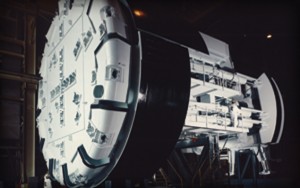![65 Years of Innovation and Experience [default]](https://www.robbinstbm.com/wp-content/uploads/2017/04/Side-Bar-Blue-Blocks_70-Years.jpg)
A Solution for Every Condition: Search our Project Database
Project Map
FEATURED PRODUCT: CROSSOVER MACHINES
Our History
A Legacy of Innovation
Information 24/7
News & Media
Insights in the Industry:
Read the Robbins Blog
 Spanning 20 years and using over 30 TBMs, Chicago’s massive Tunnel and Reservoir Plan (TARP) has been possibly the largest clean water project of the twentieth century. The TARP was created in 1975 to combat increased flooding and drainage problems that plagued Chicago and surrounding areas. After heavy rains, combined sewage overflows (CSOs) would seep into residential basements, nearby streams and rivers, as well as Lake Michigan – Chicago’s main source for drinking water. TARP was originally divided into two phases but now refers solely to Phase I.
Spanning 20 years and using over 30 TBMs, Chicago’s massive Tunnel and Reservoir Plan (TARP) has been possibly the largest clean water project of the twentieth century. The TARP was created in 1975 to combat increased flooding and drainage problems that plagued Chicago and surrounding areas. After heavy rains, combined sewage overflows (CSOs) would seep into residential basements, nearby streams and rivers, as well as Lake Michigan – Chicago’s main source for drinking water. TARP was originally divided into two phases but now refers solely to Phase I.
Phase I was directed towards pollution control and consisted of tunnels, drop shafts, and dewatering stations to eliminate nearly 85 percent of CSO pollution. Four tunnel systems comprise the first phase: Mainstream, Des Plaines, Calumet and O’Hare, which have a combined length of 176.1 km (109.4 mi) and range in diameter from 2.4 m to 10.8 m (8.0 ft to 35.4 ft). Nearly all of the tunnels were excavated in the area’s dolomitic limestone, and required the use of TBMs up to 10.8 m in diameter—the largest TBMs that had ever been built at the time.
 The Mainstream Tunnel System was composed of 65.2 km (40.5 mi) of tunnel, the Des Plaines System with 41.2 km (25.6 mi), the O’Hare System with 10.6 km (6.6 mi), and the Calumet System of 59.1 km (36.7 mi). A later tunnel for the Little Calumet Leg of the Calumet system was excavated using a Robbins TBM in 2002, setting multiple records in the process including 138 m (452 ft) bored in one day. Immediately upon completion, each tunnel system was put into service and the benefits were seen almost instantaneously. After more than 30 years and over 160 km (100 mi) of tunnels, the entire first phase of the TARP system became operational in 2005.
The Mainstream Tunnel System was composed of 65.2 km (40.5 mi) of tunnel, the Des Plaines System with 41.2 km (25.6 mi), the O’Hare System with 10.6 km (6.6 mi), and the Calumet System of 59.1 km (36.7 mi). A later tunnel for the Little Calumet Leg of the Calumet system was excavated using a Robbins TBM in 2002, setting multiple records in the process including 138 m (452 ft) bored in one day. Immediately upon completion, each tunnel system was put into service and the benefits were seen almost instantaneously. After more than 30 years and over 160 km (100 mi) of tunnels, the entire first phase of the TARP system became operational in 2005.
Phase II, now called the Chicago Underflow Plan (CUP), consists of three main reservoirs: the Majewski Reservoir, Thornton Reservoir, and McCook Reservoir with a combined capacity of 69.05 billion liters (18.24 billion gallons). The reservoirs are a joint project of the Water Reclamation District and the U.S. Army Corps of Engineers, built to provide flood relief by storing the water collected and transferred from the TARP tunnels until it can be treated at local reclamation plants.
Construction on the Majewski CUP Reservoir was started in 1990 and finished in 1998, with a capacity of 1.29 billion liters (342 million gallons). The Thornton Reservoir was divided into two stages, including a transitional reservoir completed in 2003, and a permanent CUP reservoir completed in 2015. The permanent CUP reservoir has a capacity of 29.9 billion liters (7.9 billion gallons) and provides an estimated $40 million annually to 15 communities. Finally, the McCook Reservoir, also planned as a two-stage build, will provide storage of up to 38 billion liters (10 billion gallons). The first stage was completed in 2017, while the completion date of the second stage is scheduled for 2029. To date, the reservoirs have yielded hundreds of millions of dollars in flood damage reduction benefits.
The TARP program has won numerous awards and honors over the years from the local and federal EPA, as well as the American Society of Civil Engineers award in 1986 for the most outstanding civil engineering project. The tunnels and reservoirs have resulted in a dramatic improvement to water quality in Lake Michigan, and have eliminated CSO overflows. Fish and wildlife have returned in recent years to local rivers and to Lake Michigan, and the waterfront property is becoming more attractive to businesses and the general population alike.

 Close
Close